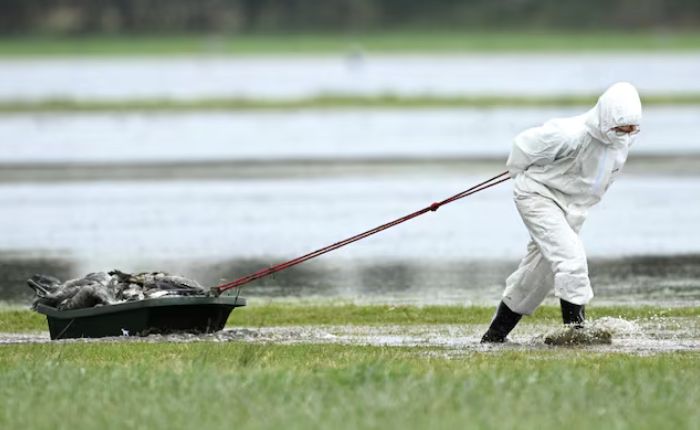
Published in Market Analysis
Avian Flu Deep Dive: Europe on "Red Alert" as Avian Flu Wave Intensifies
A "worst in three years" scenario unfolds in Germany, while Poland sees resurgence in geese and France battles breakthrough cases in vaccinated flocks.

Bo Pedersen
Chief Revenue Officer
The seasonal return of Highly Pathogenic Avian Influenza (HPAI) has arrived with unexpected ferocity this November, triggering mandatory housing orders across major producing nations and disrupting international trade. With over 300 commercial outbreaks recorded in Europe this year—and a sharp spike in the last two weeks—the industry is facing a critical winter.
The Epicenter: Germany
Status: High Risk
Germany is currently bearing the brunt of the new wave, recording what officials call the "worst bird flu wave in three years."
The Numbers: Over 100 commercial outbreaks have been recorded in 2025. The most recent consolidated data confirms 26 new outbreaks between November 6-12.
Note: Official EU reporting lags by approximately 7 days; while consolidated figures for Nov 13-19 are pending, local veterinary authorities report continued daily detections.
The Vector: The Friedrich Loeffler Institute (FLI) has identified migratory cranes as a primary vector this season, with "unusually frequent detections" in wild populations spreading the virus to farmland.
Impact: Over 1 million poultry have been culled. While egg and meat prices remain stable for now due to Germany's large production base (200m birds), the rapid spread threatens to tighten supply if it moves into key turkey-producing regions.
Context Check: Is this normal?
No. This represents a severe deviation to the upside.
Vs. Last Year: Current figures are more than double the 46 total outbreaks recorded in the entirety of 2024.
Historical Comparison: The infection rate is tracking close to the record year of 2021, signaling a "High Path" season far exceeding the typical baseline.
The Resurgence: Poland
Status: Escalating
After a period of relative calm, Poland—the EU's largest poultry producer—is back on the disease map.
The Event: Veterinary authorities confirmed H5N1 in a flock of 3,700 meat geese in Masovia (central-eastern Poland) during the reporting week ending November 12. This follows earlier isolated cases in the north.
Why it matters: Outbreaks in waterfowl are particularly dangerous as they can act as "super-spreaders" shedding high viral loads.
Market Risk: Poland is a critical supplier of goose and duck meat for the European festive market. A wider spread in Masovia could severely impact availability for Christmas 2025, driving prices up for traditional festive birds.
Context Check: Is this normal?
Concerning Trend. While Poland is accustomed to seasonal outbreaks, the timing marks the end of a "quiet" period.
Historical Comparison: The 2021/2022 "mega-wave" also began in early November (Nov 2, 2021). The current reappearance in commercial flocks aligns with the start dates of previous severe epidemic years, suggesting the sector is entering a high-risk window similar to 2021/22 rather than the milder 2023/24 season.
The Vaccination Test: France
Status: High Alert (Housing Ordered)
France has raised its national risk level to "High," triggering a mandatory housing order for all poultry.
The Concern: Despite being the only EU nation to implement a mandatory vaccination campaign for ducks (now in its third year), France has reported breakthrough infections.
The Details: Recent outbreaks in Vendée, confirmed between November 3-11, included detections in vaccinated duck flocks.
Implications: While vaccination reduces viral shedding, these cases prove it is not a silver bullet, complicating the "safe zone" narrative France has tried to build for trade partners.
Context Check: Is this normal?
Yes and No.
Vaccination Success: Overall, the strategy has worked. Outbreaks dropped from 1,374 in the catastrophic 2021-2022 season to just 10 in the 2023-2024 season (a ~99% reduction).
The Deviation: The current clusters in Vendée are a deviation from the "near-zero" baseline achieved last year, indicating that viral pressure from wild birds is now high enough to overwhelm even vaccinated immunity in some hotspots.
The UK Situation
Status: Mandatory Housing (England)
The UK has followed the continental trend, declaring a mandatory housing order for all poultry in England as of early November. Real-time reporting shows the virus is actively spreading this week:
November 18: Confirmed H5N1 in Pembrokeshire (Wales) and Suffolk (England).
November 16: Confirmed outbreak in a commercial unit in South Yorkshire.
November 15: Confirmed cases in Norfolk and Devon.
Impact: The geographic spread—from Wales to East Anglia—signals that the virus has breached biosecurity perimeters in multiple poultry heartlands simultaneously.
Context Check: Is this normal?
Above Average.
Vs. Last Season: The UK has already recorded 47 confirmed cases this season (since Oct 1, 2025). This is already more than half of the 81 cases recorded in the entirety of the 2024/2025 season, despite being only six weeks in.
Housing Order Timing: The November 6 housing order is historically early. It matches the severe 2022 season (Nov 7 order) and is significantly earlier than 2021 (Nov 29), confirming that risk levels are currently elevated well above the 5-year average.
Global Disease Watch (Outside Europe)
While Europe is the current epicenter, HPAI activity is accelerating globally as winter sets in across the Northern Hemisphere.
North America
Canada (British Columbia): The province is battling a "sudden surge" of outbreaks after months of calm. As of November 18, B.C. is dealing with over 20 active outbreaks, primarily in the Fraser Valley poultry hub. A controversial cull of 300 ostriches at a farm in Edgewood has sparked local debate, highlighting the aggressive containment stance of the Canadian Food Inspection Agency (CFIA).
United States: Commercial poultry flocks continue to be hit, with recent confirmed cases in California and Utah this November. Additionally, Washington state health officials confirmed the first-ever human case of H5N5 avian flu in the U.S. on November 17, linked to a backyard flock. While the public health risk remains low, this specific strain detection adds a new layer of complexity to surveillance efforts.
Asia
South Korea: Confirmed its fifth outbreak of the season at a chicken farm in Gyeonggi Province on November 17. Authorities have ramped up disinfection protocols, fearing a repeat of the 2020 crisis.
Japan: Reported its first seasonal outbreak in Hokkaido mid-October, putting the sector on high alert as temperatures drop.
South America
Brazil: Remains free of HPAI in commercial flocks, preserving its critical export status. However, vigilance is high following isolated wild bird cases earlier in the year.
Newcastle Disease Update: Brazil has officially declared the end of its Newcastle Disease event (which briefly halted some exports in mid-2024), clearing the way for normalized trade flows, though the threat of HPAI introduction remains the primary concern for 2026 planning.
Trade Fallout: The South Africa Ban
The most immediate commercial impact is not just culling, but market access.
The Ban: Reports confirmed on November 13 that South Africa has banned poultry imports from the entire EU and UK.
Context: The EU was once a dominant supplier to South Africa. This ban forces exporters to find new homes for dark meat and bone-in cuts typically destined for this market, potentially causing a glut of these specific products within Europe while breast meat prices rise due to production losses.
Implications & Suggested Actions
For Buyers (Retail & Foodservice):
Secure Christmas Geese/Duck Now: With Poland's Masovia region hit (confirmed week of Nov 12) and France battling outbreaks in duck heartlands, spot availability for festive birds will likely vanish. Confirm allocations immediately.
Prepare for Substitution: If turkey supply chains in the UK or Germany buckle, have a plan to switch promotions to pork or alternative poultry cuts.
For Producers:
Review Insurance: Verify that business interruption policies cover "housing order" impacts, not just culling losses.
Biosecurity Audit: The German data shows wild bird pressure is at peak levels. Re-evaluate physical barriers and entry protocols, especially regarding vehicle disinfection.
For Traders:
By-Product Pivot: With the South Africa ban confirmed as of mid-November, aggressive pricing will be needed to move dark meat and offal to alternative markets like Vietnam, Philippines, or West Africa.
Sources
WATTPoultry: Cases of avian flu continue to rise in Europe’s poultry
The Poultry Site: Germany hit by worst bird flu wave in three years
AviNews: Europe faces over 300 commercial Bird Flu outbreaks in 2025
GOV.UK: Bird flu (avian influenza): latest situation in England
FairPlay Movement: Bird flu blocks EU poultry exports to South Africa
CIDRAP: First ever human case of H5N5 avian flu confirmed in Washington state
The Star: South Korea reports another case of highly contagious bird flu
